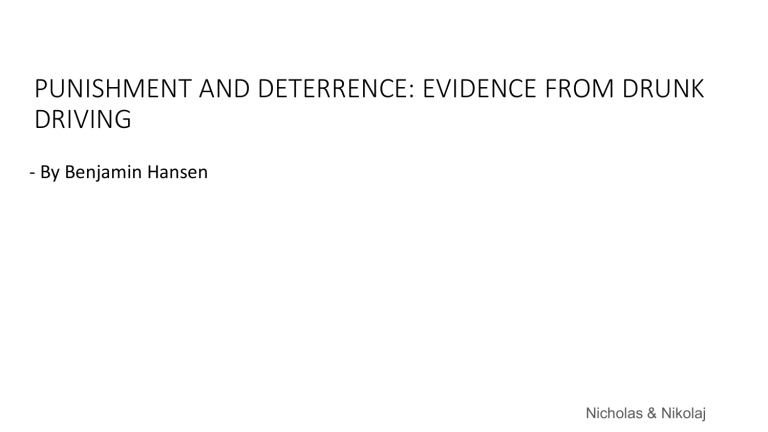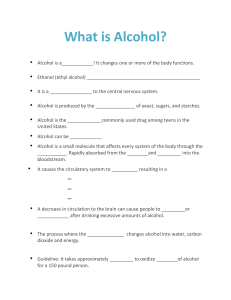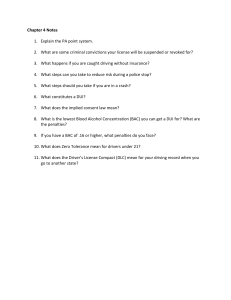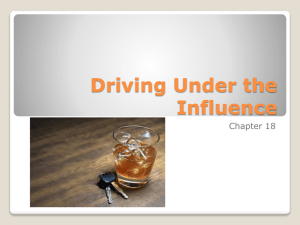Drunk Driving Deterrence: BAC Limits & Recidivism
advertisement

PUNISHMENT AND DETERRENCE: EVIDENCE FROM DRUNK DRIVING - By Benjamin Hansen Nicholas & Nikolaj Introduction Motivation: From 1975-2012 drunk driving was a factor in 585136 fatalities compared to 725347 murders in USA Research question: Do BAC limits as currently administered reduce future drunk driving? Vocabulary BAC: Blood Alcohol Concentration DUI: Driving under the influence of alcohol or other drugs Recidivism: The tendency of a previously convicted individual to reoffend Existing Literature Becker 1968 Suggests that criminals commit crimes rationally when the expected benefits of the crime outweigh the expected costs. Enhanced punishment --> Lower recidivism rates No effect Enhanced punishment --> Higher recidivism rates Abrams 2011 Lee and McCrary 2009 Chen and Shapiro 2007 Finds lower crime rates in states which enhanced punishments for committing crimes with a firearm Finding that youth respond little to the large change in penalties which occurs upon reaching 18 years of age Greater punishments in the form of harsher imprisonment condition s lead to increases in recidivism Why this variety? • Time in prison may have criminogenic effects either through peer effects or the depreciation rate of human capital. • Higher prison sentences change the age of an individual at the time of release. As such, the age of an individual may directly affect the trade-offs an individual faces when choosing between crime and traditional labour supply Why drunk driving? o Punishments and sanctions for drunk driving lack many of the challenges normally present in testing the deterrent effect of punishments o 1: Being stopped for drunk driving is a purely reactive process o In other circumstances, police often choose who to investigate based on previous offenses or convictions o 2: Measuring recidivism in terms of DUI (or refusal of test) avoids problems/bias with when to record recidivism (arrest, charge or conviction) o 3: Milder prison (or driving restriction) sentences remove potential demographic effects of longer sentences Empirical Strategy The specific cut-offs for DUI and aggravated DUI allow the sharp RD to test the effect of punishment severity on recidivism. ● How much does the punishment increase Identifying Assumptions ● For identification, the following assumptions need to be met: ○ ○ Continuity of other variables ■ Only treatment status can have an expected change across the threshold No perfect manipulation! ■ Meaning that some drivers are randomly lucky, and some are not Continuity of other variables at the threshold ● Fail to reject the null that the predetermined characteristics are unrelated to the BAC cut-off. Manipulation at the threshold? Why does this assumption hold? ● ● Speed of alcohol consumption, food intake, hydration, activity, and metabolism are difficult to measure, making any BAC calculation based on consumption and physical characteristics a rough approximation. Personal breathalysers is available for individuals to purchase, But they are far more volatile than the official breathalysers used. Estimation Procedure ● Regression model: ● DUI → Indicator of the threshold ● y → 0, if they are not pulled over by police in next 4 years. --> 1, if there are subjected to a test or refuse a test ● Slopes can change at the threshold ● Weighted with a rectangular Kernel - (Sensitivity are checked with other kernels) ● Bandwidth of 0.05 and 0.025 - (Sensitivity are checked with other bandwidths) ● Local linear specification ● All observations are clustered at finest bin BAC (0.001). This captures autocorrelation between individuals. which have similar BAC levels. Data ● Administrative records on 512,964 DUI BAC tests in the state of Washington from 1995 to 2011. ● In 1999, Washington applied a 0.08 threshold for determining DUI, and 0.15 threshold for an aggravated DUI. ● An example: After a positive test in 1/1/1999, the paper investigates recidivism for that specific individual from 2/1/1999 to 1/1/2003 Results DUI Threshold ● Notable drop at 0.08 and 0.15 threshold ● Having a BAC above the .08 threshold decreases recidivism by 2 %points, and is statistically significant ● The results suggest having a BAC over the DUI threshold results in either less drunk driving or more attentive drunk driving later. ● Importantly, those with prior tests reduce their recidivism by a larger margin. This could be because the expected penalties are much higher if they are caught drunk driving again Results DUI Aggravated Threshold ● ● Having a BAC above the aggravated DUI threshold reduces recidivism for all potential offenders by 1.1 % points, for those with no prior tests by 0.9 percentage points, and those with prior tests by 1.9 percentage points. They are all highly significant Why is the linear specification a reasonable choice ● ● The stability of the estimates across various bandwidths suggests that the linear specification is a reasonable choice Smaller bandwidths decrease precision → Decrease in sample size Disaggregated recidivism levels Heterogeneity of recidivism ● For the entire population of suspected drunk drivers, having a BAC above the 0.08 threshold results in a decreased likelihood of being stopped and having a BAC in any of the recidivism categories. ● Those with at least 1 prior test have a large and significant reduction in the probability of being in a subsequent accident involving alcohol ● The estimates suggest that having a BAC above the aggravated DUI threshold decreases the likelihood of recidivating in all the BAC content categories. First stage ● Having a BAC over the 0.08 threshold is associated with an increase in essentially all the potential sanctions an individual could receive. --> Good first stage! Incapacitation ● ● ● Is the previous estimates driven by long run changes in behaviour or short run changes due to incapacitation Typical jail time for drunk driving : 24 hours - few months We see both a short-term and long-term reduction in recidivism Rehabilitation ● Victims panel, taking an alcohol abuse assessment, and receiving alcohol treatment. ● Reduce drunk driving only because it reduces future alcohol consumption ● So let us test if other alcohol related incidents decreases at the 0.08 and 0.15 threshold ● No significant values Conclusion ● ● ● This paper finds evidence that having a BAC above either .08 DUI threshold or the .15 aggravated DUI is associated with reduced recidivism both in the short and long term. This would suggest that the sanctions and ones imposed at current BAC thresholds are effective Notice, in research question it is difficult/not possible to separate the ”direct effect” of receiving a punishment, or the effect of the “raised punishment” for recidivism


